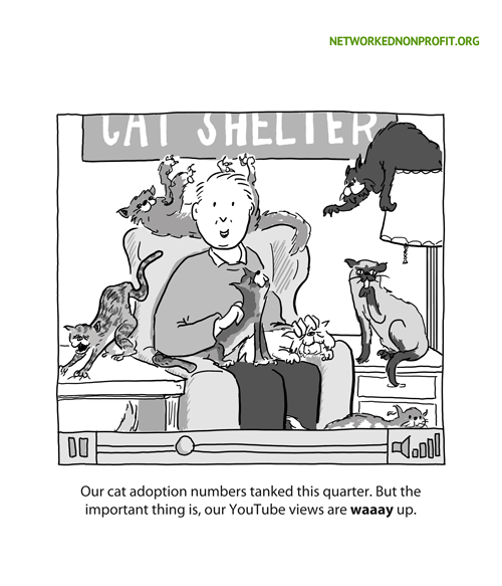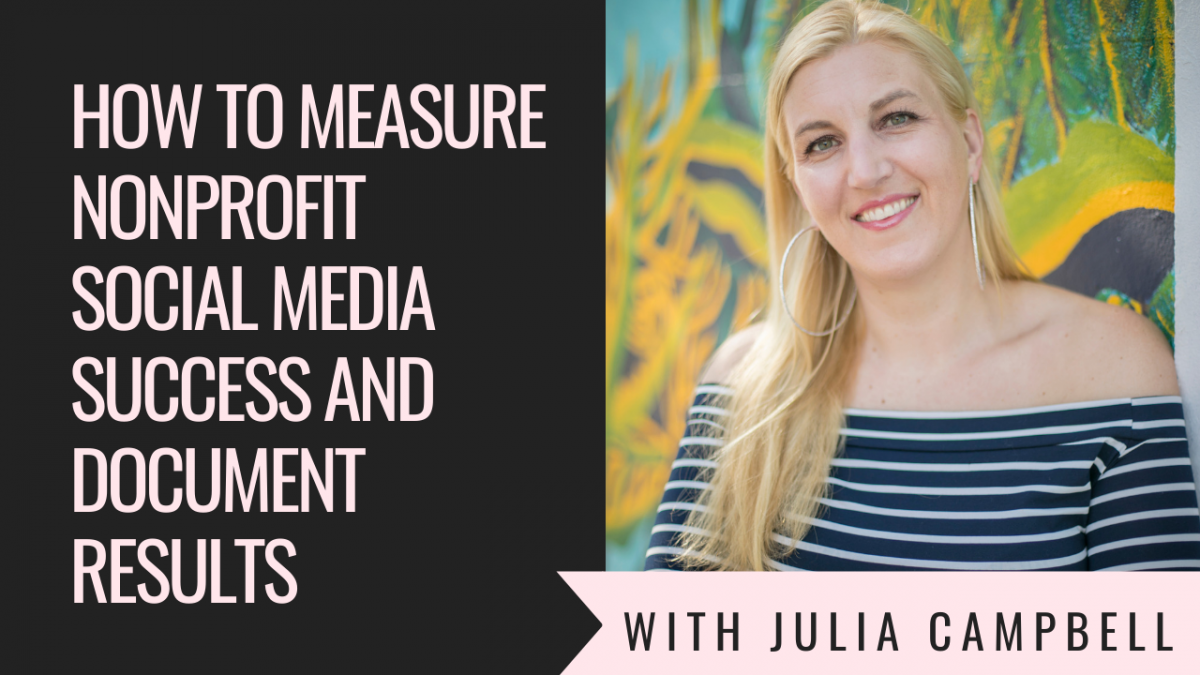Don’t get me wrong.
I think it’s fantastic when nonprofits want to measure social media success and document their results.
In fact, it’s vital – consistent measurement is something I strongly recommend (a.k.a. require) of all my clients.
Without measurement and analysis:
- How will you know what to improve upon?
- If you don’t know where you want to go, how will you know when you get there?
- How will you know that you have taken the right road?
- How will you know how to get there again, and again?
This brings me to my big problem with the majority of social media measurement tools and spreadsheets.
They only measure the numbers of followers, likes, views – also called vanity metrics.
Vanity metrics may make you feel good—“Look, 10 new Twitter followers this week!” —but the numbers alone are not telling the story of progress towards your goal.
Sure, you do want to see a steady increase in those kinds of numbers over time – and you certainly don’t want to backslide and lose followers and fans.
But, they are not the most important statistics to follow in your quest for social media success.
Ask yourself – Are you getting more people to take action on the issue? Are you receiving more inquiries for donations? Are your events well-attended?
To determine what to measure, we need a combination of “vanity metrics” and goal-specific metrics.
 As Beth Kanter wrote on her blog, nonprofits need to use the “Say So What To Your Data Three Times” principle.
As Beth Kanter wrote on her blog, nonprofits need to use the “Say So What To Your Data Three Times” principle.
When you see a spike in website traffic or Facebook engagement, ask – So what? Where did the traffic originate from? What are the possible reasons for an increase in engagement?
Find out where the website traffic or increased engagement originated.
It may have come as a result of your nonprofit being mentioned in the news, or being retweeted by an influencer, or through sharing a perspective on a trending news story. Ask again – So what?
Did it result in more email sign-ups? Petition signatures? Membership inquiries? Online donations?
Did it help you achieve your desired strategies and move you towards your stated goal?
Remember that “raised awareness” in your online community does not automatically translate into action.
So how should you measure the real value of social media for community building? Here are a few tips:
Go back to your goals.
The metrics that you measure will help determine the effectiveness of the goals and the accompanying tasks that you choose.
| Goals | Tasks | Metrics to Measure Effectiveness |
| (Example) Get people excited about what we do. | (Example) Share a weekly video on Facebook that goes behind the scenes of our work and highlights staff and volunteers. Create graphics and visuals about our work that people can easily share on social. | Blog post traffic Blog subscribers Facebook engagement Facebook followers Facebook referral traffic to website/email sign-ups |
| (Example) Shed light on the issue in a compelling way. | Share timely news each week on the issue with our commentary and perspective. Share posts that invite discussion and debate from our community. | Video views Video engagement Website traffic Donation page clicks Conversions (how many people clicked on the page and completed a donation) |
| (Example) Share more inspiring stories. | Share Instagram Stories once per week from the field. Hold a digital storytelling training for staff and board members. Invest in a video series depicting transformational client stories. | Instagram Stories views Instagram engagement Instagram followers Staff collecting stories Staff sharing stories Video views Video engagement |
Always remember the true value of achieving your goal.
The value does not lie simply in increasing the number of Twitter followers or Facebook fans. Dig deeper.
The value of achieving success in building a community on social media can be linked to:
- Increased donations and revenue.
- New donor prospects.
- Word-of-mouth goodwill for the organization.
- Ability to hire and train more staff.
- Ability to serve more clients.
- Prestige as a reputable and successful nonprofit organization.
- Greatly enhanced media and community relationships.
- Increased positive coverage in local media.
- Increased community partnerships.
Facebook Likes are nice, but engaging people and getting them to take your desired action is nicer!
Keep your eye on the big picture and always dig deeper into your metrics – that will help you find focus on those days when it seems you are spinning your wheels.
Going beyond numbers and quantitative data, there are three qualitative ways to determine nonprofit marketing success, of which social media is certainly a large part:
1) Your fans would put your bumper sticker on their car (or a frame on their Facebook profile).
Car, laptop, Hydroflask, Trapper Keeper – your fans love you so much that they would put your sticker on their most valuable possessions.
They would wear your t-shirt, drink from your coffee mug, and use your branded water bottle.
Your social media platforms should be cultivating this sense of community.
In the digital space, in lieu of physical bumper stickers, you can create cover art and photo frames for people to use on their profiles.
Susan G. Komen Florida offers a variety of Facebook profile frames that supporters can use to show their public support for the cause on social.
Save Buzzards Bay is a small environmental protection nonprofit, and they send out physical bumper stickers to their donors, with a digital ask to post them to social media using their hashtag.
There is such power in getting your supporters to brandish your logo in public, showing it off to their networks.
This is the way that we identify and showcase to others what we stand for. It’s a public declaration of our values and our worldview.
It’s also the way that we attract like-minded people that stand for the same things. I feel an instant kinship with others who support the same charities.
It helps us build our communities, establish our personalities, and make connections online.
2) You aren’t afraid of haters.
Haters, trolls on the interwebs – they don’t scare you!
If your social media work is thriving, you simply brush your shoulders off when you see a negative comment online.
You aren’t worried about criticism on social media, because you know that your online community has your back.
You have confidence in your community members.
They are there for you.
They will step up to bat, insert themselves in conversations to set the record straight, and defend you to people who hate on your org, your cause, and your issue. Because an attack on you is an attack on them – what they stand for and who they are down to their very core.
3) You feel genuinely proud.
You know that feeling that you can’t put your finger on, when things are going well and you feel like you are really doing work that matters?
The way to know if your social media marketing is working, or on it’s way to really working, is if you feel good about it.
You don’t feel slimy. You don’t feel evil. You don’t feel smarmy, or manipulative, or yucky about the marketing messages you send out.
Instead, you feel like you are building something.
The only way to do this is to act like a human, and not a faceless brand.
Focus on making real connections, not just pushing out promotions to get a few more clicks.
Pride in your work also means that you know you could approach your community with an ask, and they would respond.
They would provide feedback. They would open their wallets.
Remember – the only true currency on social media is trust and attention, and the only way to get it is through valuable communication that is desired and needed by your online community.
Get your copy of my new book, How to Build and Mobilize A Social Media Community for Your Nonprofit in 90 Days!
